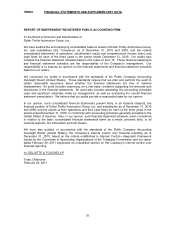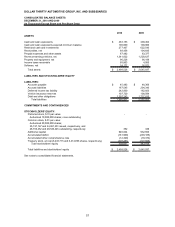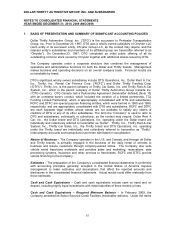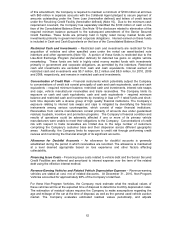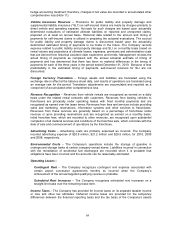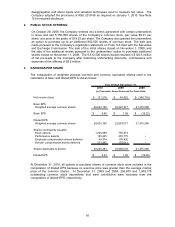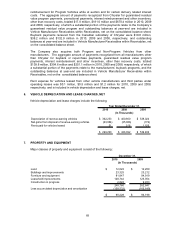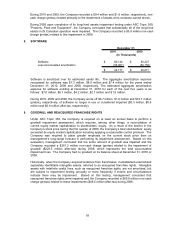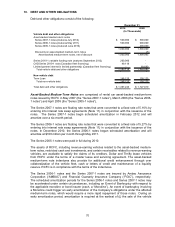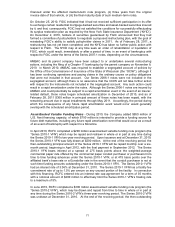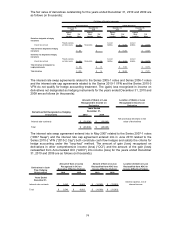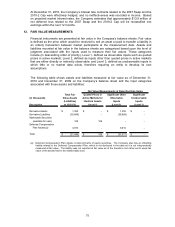Thrifty Car Rental 2010 Annual Report Download - page 66
Download and view the complete annual report
Please find page 66 of the 2010 Thrifty Car Rental annual report below. You can navigate through the pages in the report by either clicking on the pages listed below, or by using the keyword search tool below to find specific information within the annual report.and liabilities. A valuation allowance is recorded for deferred income tax assets when
management determines it is more likely than not that such assets will not be realized. The
Company has established a valuation allowance related to DTG Canada and a portion of the
Company’s net operating losses for state tax purposes. The Company evaluates its tax
policies quarterly under ASC Topic 740, “Income Taxes” (“ASC Topic 740”) to identify uncertain
tax positions.
Earnings Per Share – Basic earnings per share (“EPS”) is computed by dividing net income
(loss) by the weighted average number of common shares outstanding during the period.
Diluted EPS is based on the combined weighted average number of common shares and
common share equivalents outstanding which include, where appropriate, the assumed
exercise of options. In computing diluted EPS, the Company has utilized the treasury stock
method.
Stock-Based Compensation – The Company uses the fair value-based method of accounting
for stock-based compensation. All performance share, restricted stock and stock option
awards are accounted for using the fair value-based method for the 2010, 2009 and 2008
periods. The Company issued common shares to its Board of Directors for attendance at
Board of Director committee meetings in 2008. Payment for attendance at Board of Directors
committee meetings was paid in cash in 2009 and 2010. The fair value of these common
shares is determined based on the closing market price of the Company’s common shares at
the specific date on which the shares were earned and is recorded as a liability on the
Company’s books until they are issued. In 2010, the Company did not issue any stock options.
In 2009 and 2008, the Company issued approximately 1,120,000 and 1,258,000 stock options
at a weighted average grant-date fair value per share of $4.44 and $7.58, respectively.
New Accounting Standards –
In May 2009, the Financial Accounting Standards Board (“FASB”) issued guidance related to
subsequent events, which is included in Accounting Standards Codification (“ASC”) topic 855,
“Subsequent Events” ("ASC Topic 855”) and is effective for interim periods ending after June
15, 2009. In February 2010, the FASB amended ASC Topic 855 for clarification of disclosure
requirements for subsequent events. The provisions require Company management to
evaluate events or transactions occurring subsequent to the balance sheet date but prior to the
issuance of the financial statements for potential recognition or disclosure in the financial
statements and to disclose the results of management’s findings in the financial statements. In
addition, the provisions identify the circumstances under which an entity shall recognize events
or transactions occurring after the balance sheet date in its financial statements and the
required disclosures of such events. The Company adopted the provisions as required
beginning with the period ended June 30, 2009. See Note 19 for required disclosure.
In December 2009, the FASB issued Accounting Standards Update (“ASU”) 2009-17,
“Consolidations (ASC Topic 810): Improvements to Financial Reporting by Enterprises
Involved with Variable Interest Entities” (“ASU 2009-17”), which is effective for annual periods
beginning after November 15, 2009. ASU 2009-17 requires Company management to
consider the other entity’s purpose and design and the reporting entity’s ability to direct the
activities of the other entity that most significantly impact the other entity’s economic
performance when determining whether a variable interest entity should be consolidated. The
Company adopted the provisions of ASU 2009-17 as required on January 1, 2010. The
provisions had no impact on the Company’s consolidated financial statements upon adoption.
In January 2010, the FASB issued ASU 2010-06, “Fair Value Measurements and Disclosures
(ASC Topic 820): Improving Disclosures about Fair Value Measurements” which amends ASC
Subtopic 820, “Fair Value Measurements and Disclosures” (“ASU 2010-06”) to add new
requirements for disclosures about transfers into and out of Levels 1 and 2 and separate
disclosures about purchases, sales, issuances, and settlements relating to Level 3
measurements. ASU 2010-06 also clarifies existing fair value disclosures about the level of
65


